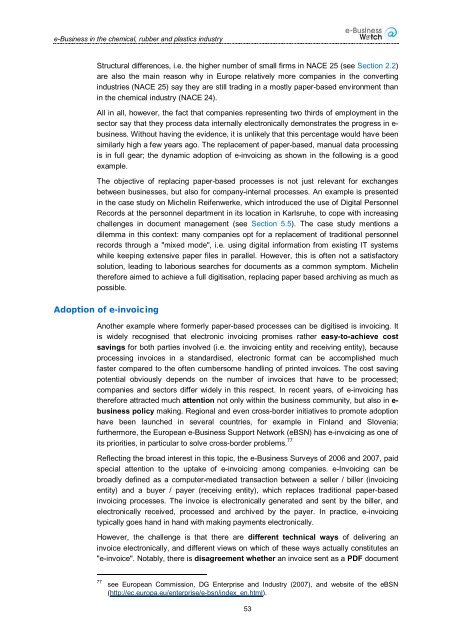Downloads - empirica
Downloads - empirica
Downloads - empirica
You also want an ePaper? Increase the reach of your titles
YUMPU automatically turns print PDFs into web optimized ePapers that Google loves.
e-Business in the chemical, rubber and plastics industryStructural differences, i.e. the higher number of small firms in NACE 25 (see Section 2.2)are also the main reason why in Europe relatively more companies in the convertingindustries (NACE 25) say they are still trading in a mostly paper-based environment thanin the chemical industry (NACE 24).All in all, however, the fact that companies representing two thirds of employment in thesector say that they process data internally electronically demonstrates the progress in e-business. Without having the evidence, it is unlikely that this percentage would have beensimilarly high a few years ago. The replacement of paper-based, manual data processingis in full gear; the dynamic adoption of e-invoicing as shown in the following is a goodexample.The objective of replacing paper-based processes is not just relevant for exchangesbetween businesses, but also for company-internal processes. An example is presentedin the case study on Michelin Reifenwerke, which introduced the use of Digital PersonnelRecords at the personnel department in its location in Karlsruhe, to cope with increasingchallenges in document management (see Section 5.5). The case study mentions adilemma in this context: many companies opt for a replacement of traditional personnelrecords through a "mixed mode", i.e. using digital information from existing IT systemswhile keeping extensive paper files in parallel. However, this is often not a satisfactorysolution, leading to laborious searches for documents as a common symptom. Michelintherefore aimed to achieve a full digitisation, replacing paper based archiving as much aspossible.Adoption of e-invoicingAnother example where formerly paper-based processes can be digitised is invoicing. Itis widely recognised that electronic invoicing promises rather easy-to-achieve costsavings for both parties involved (i.e. the invoicing entity and receiving entity), becauseprocessing invoices in a standardised, electronic format can be accomplished muchfaster compared to the often cumbersome handling of printed invoices. The cost savingpotential obviously depends on the number of invoices that have to be processed;companies and sectors differ widely in this respect. In recent years, of e-invoicing hastherefore attracted much attention not only within the business community, but also in e-business policy making. Regional and even cross-border initiatives to promote adoptionhave been launched in several countries, for example in Finland and Slovenia;furthermore, the European e-Business Support Network (eBSN) has e-invoicing as one ofits priorities, in particular to solve cross-border problems. 77Reflecting the broad interest in this topic, the e-Business Surveys of 2006 and 2007, paidspecial attention to the uptake of e-invoicing among companies. e-Invoicing can bebroadly defined as a computer-mediated transaction between a seller / biller (invoicingentity) and a buyer / payer (receiving entity), which replaces traditional paper-basedinvoicing processes. The invoice is electronically generated and sent by the biller, andelectronically received, processed and archived by the payer. In practice, e-invoicingtypically goes hand in hand with making payments electronically.However, the challenge is that there are different technical ways of delivering aninvoice electronically, and different views on which of these ways actually constitutes an"e-invoice". Notably, there is disagreement whether an invoice sent as a PDF document77see European Commission, DG Enterprise and Industry (2007), and website of the eBSN(http://ec.europa.eu/enterprise/e-bsn/index_en.html).53
















